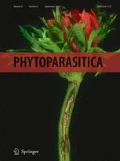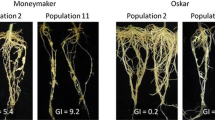Abstract
Root-knot nematodes (Meloidogyne spp.; RKN) are one of the most important pathogens of vegetables in Turkey. Assessing the existing virulent RKN populations is of importance for pathogen mapping in the west Mediterranean region of Turkey. Therefore, 95 populations of RKN were collected from different protected vegetable-growing locations in the region. Pure cultures were obtained and identified by means of species-specific primers. Virulence of the populations against the Mi-1 gene conferring resistance to Meloidogyne incognita, M. javanica and M. arenaria was determined according to their egg masses and gall rating on resistant and susceptible tomato varieties. Results showed that seven populations of M. incognita and six populations of M. javanica were able to overcome the resistance controlled by the Mi-1 gene. The frequency of virulent populations of M. incognita and M. javanica collected from different protected-grown vegetables was 11.7% and 21.4%, respectively. To our knowledge, this is the first report of populations of RKN virulent to the Mi-1 gene in Turkey.
Similar content being viewed by others
References
Anon. (2008). Crop production statistics. Turkish Statistical Institute, Ankara, Turkey. http://www.tuik.gov.tr/VeriBilgi.do?tb_id=45&ust_id=13. Accessed 5 March 2010.
Barker, K. R. (1985). Nematode extraction and bioassays. In K. R. Barker, C. C. Carter, & J. N. Sasser (Eds.), Advanced treatise on Meloidogyne: 2 methodology (pp. 19–35). Raleigh, NC, USA: North Carolina State University Graphics.
Castagnone-Sereno, P., Bongiovanni, M., & Dalmasso, A. (1993). Stable virulence against the tomato resistance Mi gene in the parthenogenetic root-knot nematode Meloidogyne incognita. Phytopathology, 83, 803–805.
Castagnone-Sereno, P., Bongiovanni, M., & Dalmasso, A. (1994). Reproduction of virulent isolates of Meloidogyne incognita on susceptible and Mi-resistant tomato. Journal of Nematology, 26, 324–328.
Devran, Z., & Söğüt, M. A. (2009). Distribution and identification of root-knot nematodes from Turkey. Journal of Nematology, 41, 128–133.
Devran, Z., Söğüt, M. A., Özarslandan, A., Göçmen, M., & İkten, H. (2009). Distribution of root-knot nematodes (Meloidogyne spp.) in the West Mediterranean region of Turkey. 61 st International Symposium on Crop Protection (Gent, Belgium), p. 200.
Devran, Z., Söğüt, M. A., & Mutlu, N. (2010). Response of tomato rootstocks with the Mi resistance gene to Meloidogyne incognita race 2 at different soil temperatures. Phytopathologia Mediterranea, 49, 11–17.
Dropkin, V. H. (1969). The necrotic reaction of tomatoes and other hosts resistant to Meloidogyne: reversal by temperature. Phytopathology, 59, 1632–1637.
Eddaoudi, M., Ammati, M., & Rammah, A. (1997). Identification of resistance breaking populations of Meloidogyne on tomatoes in Morocco and their effect on new sources of resistance. Fundamental and Applied Nematology, 20, 285–289.
Jarquin-Barberena, H., Dalmasso, A., de Guiran, G., & Cardin, M. C. (1991). Acquired virulence in the plant parasitic nematode Meloidogyne incognita. I. Biological analysis of the phenomenon. Revue de Nematologie, 14, 261–275.
Lopez-Perez, J. A., le Strange, M., Kaloshian, I., & Ploeg, A. T. (2006). Differential response of Mi gene-resistant tomato rootstocks to root-knot nematodes (Meloidogyne incognita). Crop Protection, 25, 382–388.
Molinari, S., & Miacola, C. (1997). Interactions between resistant tomato cultivars and Meloidogyne spp. in vitro. Nematologia Mediterranea, 25, 63–71.
Noling, J. W. (2000). Effects of continuous culture of a resistant tomato cultivar on Meloidogyne incognita soil population density and pathogenicity. Journal of Nematology, 32, 452.
Ornat, C., Verdejo-Lucas, S., & Sorribas, F. J. (2001). A population of Meloidogyne javanica in Spain virulent to the Mi resistance gene in tomato. Plant Disease, 85, 271–276.
Rich, J. R., & Olson, S. M. (1999). Utility of Mi gene resistance in tomato to manage Meloidogyne javanica in North Florida. Journal of Nematology (Supplement), 31, 715–718.
Roberts, P. A. (1995). Conceptual and practical aspects of variability in Meloidogyne related to host plant resistance. Annual Review of Phytopathology, 33, 199–221.
Roberts, P. A., Dalmasso, A., Cap, G. B., & Castagnone-Sereno, P. (1990). Resistance in Lycopersicon peruvianum to isolates of Mi gene-compatible Meloidogyne populations. Journal of Nematology, 22, 585–589.
Roberts, P. A., & Thomason, I. J. (1986). Variability in reproduction of isolates of Meloidogyne incognita and M. javanica on resistant tomato genotypes. Plant Disease, 70, 547–551.
Roberts, P. A., & Thomason, I. J. (1989). A review of variability in four Meloidogyne spp. measured by reproduction on several hosts including Lycopersicon. Agricultural Zoology Reviews, 3, 225–252.
Sorribas, F. J., Ornat, C., Verdejo-Lucas, S., Galeano, M., & Valero, J. (2005). Effectiveness and profitability of the Mi resistant tomatoes to control root-knot nematodes. European Journal of Plant Pathology, 111, 29–38.
Tzortzakakis, E. A., Adam, M. A. M., Blok, V. C., Paraskevopoulos, C., & Bourtzis, K. (2005). Occurrence of resistance-breaking populations of root-knot nematodes on tomato in Greece. European Journal of Plant Pathology, 113, 101–105.
Tzortzakakis, E. A., Blok, V. C., Phillips, M. S., & Trudgill, D. L. (1999). Variation in root-knot nematodes (Meloidogyne spp.) in Crete in relation to control with resistant tomato and pepper. Nematology, 1, 499–506.
Tzortzakakis, E. A., Trudgill, D. L., & Phillips, M. S. (1998). Evidence for a dosage effect of the Mi gene on partially virulent isolates of Meloidogyne javanica. Journal of Nematology, 30, 76–80.
Veremis, J. C., & Roberts, P. A. (1996). Differentiation of Meloidogyne incognita and M. arenaria novel resistance phenotypes in Lycopersicon peruvianum and derived bridge lines. Theoretical and Applied Genetics, 93, 960–967.
Acknowledgments
Seeds of the resistant and susceptible tomato varieties were kindly provided by Yüksel Seeds Ltd. (Antalya, Turkey) and Multi Tarım Ltd. (Antalya, Turkey), respectively. This study was supported financially by The Scientific and Technological Research Council of Turkey as project no. TOVAG-107 O 016. The authors wish to thank Mehmet Ülger (General Director, Multi Tarım, Antalya, Turkey) for allowing the studies to be carried out in the Multi Tarım Co. facilities; and Ömür Baysal (BATEM, Antalya, Turkey) and Nedim Mutlu (Akdeniz University, Seed and Agricultural Biotechnology Center, Antalya, Turkey) for reading the manuscript.
Author information
Authors and Affiliations
Corresponding author
Rights and permissions
About this article
Cite this article
Devran, Z., Söğüt, M.A. Occurrence of virulent root-knot nematode populations on tomatoes bearing the Mi gene in protected vegetable-growing areas of Turkey. Phytoparasitica 38, 245–251 (2010). https://doi.org/10.1007/s12600-010-0103-y
Received:
Accepted:
Published:
Issue Date:
DOI: https://doi.org/10.1007/s12600-010-0103-y




